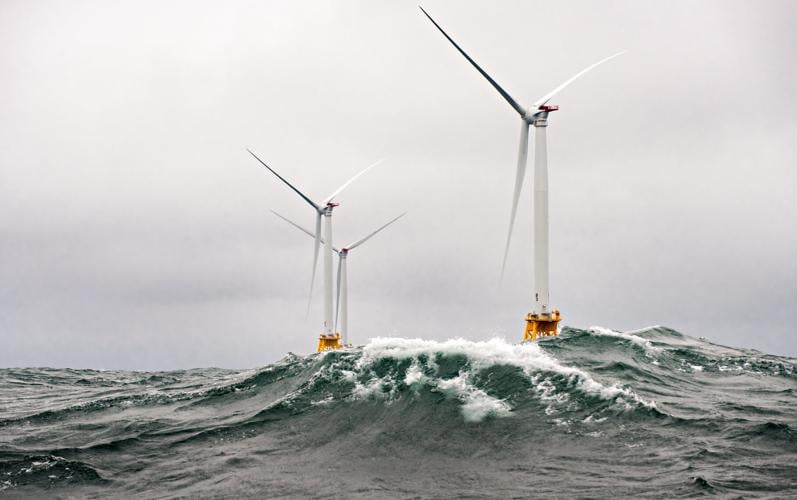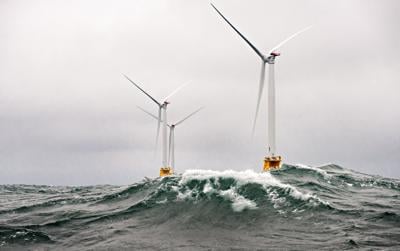The Gulf of Mexico’s first slate of offshore wind farms will have much less space than the federal government proposed late last year.
A new wind energy lease sale plan released Wednesday by the U.S. Bureau of Ocean Energy Management slashes the Gulf’s offshore wind energy development areas by two-thirds, potentially reducing the amount of jobs and clean energy the region’s leaders had hoped wind farms would generate in the coming years. BOEM’s decision to cut the size of wind energy areas is aimed at easing potential conflicts with the Gulf’s many other users, including the oil and gas industry, shipping companies and the military.
The new boundaries include a 102,000-acre area south of Lake Charles, and two areas near Galveston, Texas that will likely be trimmed to one zone stretching across about 100,000 acres. The Gulf’s total combined area will likely be just under 200,000 acres, according BOEM officials. That’s a substantial reduction from the 682,000 acres BOEM proposed in October.

It’s unclear how much the smaller areas may dampen the prospects for offshore wind development, which has been promoted as a potent force for job creation and clean energy in a region with deep but fading ties to the oil and gas industry.
BOEM had estimated the larger, 682,000-acre area could generate power for almost 3 million homes or enough electricity for all the residents of Houston, New Orleans and Baton Rouge. On Wednesday, BOEM cut its estimate down to 1.3 million homes, but that number could be cut again after the two Galveston zones are reduced to a single area.
A host of industrial and ecological concerns have been raised about offshore wind in the Gulf. The region gets heavy use by the oil and gas, shipping and fishing industries – all which have urged BOEM to keep wind turbines clear of the areas where they operate. The U.S. Defense Department and the Coast Guard also asked for additional limits for marine navigation and military operations.
Most public input on the wind zones came from Texas groups and residents. The survival of migratory birds, which cross the Gulf by the millions every year, was a primary concern expressed by many Texas residents.

Mandeville-based Keystone Engineering and several other Louisiana companies helped design and build the Block Island Wind Farm off the coast of Rhode Island in 2016. Block Island was the first offshore wind farm in U.S. waters.
Despite the steep reduction in the area available for wind farms, business leaders remain optimistic about the industry’s future in the Gulf, noting that BOEM is likely to open more offshore wind areas in later development phases.
State Rep. Joseph Orgeron, a Larose Republican who works in the offshore wind industry, doubts the reduction will have much of an impact. BOEM is essentially trimming the fat, leaving plenty of prime offshore real estate for the nascent industry to make its first forays into the Gulf, he said.
“We still have a hell of a lot of open area to put some very large projects,” said Orgeron, who helped build the U.S.’s first offshore wind farm, a project completed off the coast of Rhode Island in 2016, and owns 2nd Wind Marine in Galliano. “The original area (BOEM proposed) was maybe an overstatement of what was realistic, but now they’re throttling it back.”

Recreational fishing boats pass wind turbines in the Atlantic Ocean near Block Island, Rhode Island, in September 2021.
RWE, a German energy company and one of the world's largest wind developers, remains interested in building wind farms near Louisiana.
"Despite the reduction in the Louisiana lease area size, we still see opportunity for commercial-scale offshore wind projects in the Gulf," said Katie Theoharides, an RWE manager for wind projects in the U.S.
Michael Hecht, CEO of the economic development organization Greater New Orleans Inc., said Louisiana’s offshore oil and gas industry offers a “preexisting energy workforce” that will benefit from the growth of offshore wind whether it’s in the Gulf or elsewhere. Several Louisiana companies, including metal fabricators, boat operators and marine engineers, have seen their employment prospects in the oil and gas industry fade just as new opportunities have opened at wind farm projects on the East Coast.
BOEM’s decision to reduce the Gulf’s offshore wind areas comes as the agency kicks off a months-long process that will eventually lead to an offshore wind area auction, possibly later this year.

The platforms for these wind turbines in the Atlantic Ocean near Block Island, Rhode Island, were made in south Louisiana.
The American Clean Power Association called the start of the auction process “another significant milestone” for wind energy production in the Gulf.
“This proposed lease sale will continue the legacy of energy production in the Gulf of Mexico (and provide) Americans with an affordable clean energy supply,” said Josh Kaplowitz, the association’s vice president for offshore wind.
BOEM is proposing several lease requirements aimed at boosting economic development in the Gulf region. The agency may mandate that bidders offer support for wind energy workforce training programs and a special fund that would compensate commercial fishers who are negatively affected by wind farms.
Opening more federal waters to offshore wind is part of a push by President Joe Biden's administration to generate 30 gigawatts of offshore wind power by 2030. So far, two offshore wind farms are operating in U.S. waters and two more are under construction near Massachusetts and New York. Several more projects are planned along the East Coast.
Despite progress elsewhere, the Biden administration recently delayed the Gulf’s planned auction date by at least six months, citing a stipulation in the Inflation Reduction Act that requires the government to prioritize new offshore drilling opportunities over wind and other renewable energy projects.
Winds of Change: How the Gulf of Mexico could be the next offshore wind powerhouse
Wind turbines could attract fish but damage shrimp nets and other gear
Several environmental groups are petitioning federal regulators to require employers to document a wider range of illnesses, including cold- a…










